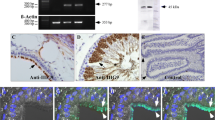Abstract
We have developed a new in vitro method of quantitatively analyzing ciliary movement in the ependymal wall of the aqueduct in rats. An axial slice of the midbrain containing ependymal wall was placed in a culture dish filled with a culture medium containing latex beads 1 μm in diameter at a concentration of 107 beads/ml. The movement of the beads caused by flow of culture medium generated by the to-and-fro ciliary movement was recorded by a high speed video system attached to an inverted phase-contrast microscope. Ciliary movement was expressed by the speed of the latex beads (μm/s). Aqueductal ciliary movement in congenitally hydrocephalic HTX rats, congenitally hydrocephalic WIC-Hyd rats, and other normal rats was evaluated. The results suggest that in congenitally hydrocephalic WIC-Hyd rats the degree of hydrocephalus related strongly to the degree of ciliary dyskinesia, but in congenitally hydrocephalic HTX rats it did not. Considering this discrepancy, we attempted to see whether or not hydrocephalus was caused by artificial disturbance of ependymal ciliary movement in vivo. We found that continuous infusion of metavana date, an inhibitor of ciliary movement, into the III ventricle of normal Sprague-Dawley rats for 7 days induced dilatation of the ventricular system. Although the question whether or not disturbance of aqueductal ependymal ciliary movement is related to the development of human congenital hydrocephalus is debatable, the results of the present in vitro and in vivo experimental investigations appear to suggest that the disturbance of ciliary movement in the aqueduct could at least be one of the factors contributing to the inducement of hydrocephalus in experimental conditions.
Similar content being viewed by others
References
Afzelius BA (1979) The immotile-cilia syndrome and other ciliary disease. Int Rev Exp Pathol 19:1–43
Brightman MW, Palay SL (1963) The fine structure of ependyma in the brain of the rat. J Cell Biol 19:415–439
Cathcart RS, Worthington WC Jr (1964) Ciliary movement in the rat cerebral ventricle: clearing action and direction of current. J Neuropathol Exp Neurol 23:609–618
DeSanti MM, Magni A, Valletta EA, Gardi C, Lungarella G (1990) Hydrocephalus, bronchiectasis, and ciliary aplasia. Arch Dis Child 65:543–544
Gibbon IR (1961) The relationship between the fine structure and direction of beat in gill cilia of lamellibranch molluse. J Biophys Biochem Cytol 11:179–205
Gibbon IR, Cosson MP, Evans JA, Gibbon BH, Houck B, Martinson KH, Sale WS, Tang WY (1978) Potent inhibition of dynein adenosinetriphosphatase and of the motility of cilia and sperma flagella by vanadate. Proc Natl Acad Sci USA 75:2220–2224
Go KG, Stokroos I, Blaauw EH, Fuiderveen F, Molenaar I (1976) Changes of ventricular ependyma and choroid plexus in experimental hydrocephalus, as observed by scanning electron microscopy. Acta Neuropathol (Berl) 34:55–64
Goodenough UW, Heuser JE (1985) Outer and inner dynein arms of cilia and flagella. Cell 41:341–342
Greenstone MA, Jones RWA, Dewar A, Neville BGR, Cole PJ (1984) Hydrocephalus and primary ciliary dyskinesia. Arch Dis Child 59:481–482
Jaburian Z, Lublin FD, Adler A, Gonzales C, Northrup B, Zwillenberg D (1986) Hydrocephalus in Kartagener's syndrome. J Ear Nose Throat 65:465–472
Kartagener M (1933) Zur Pathogenese der Bronchiektasien. Beitr Klin Erforsch Tuberk Lungenkr 83:483
Kohn DF, Chinookoswong N, Chou SM (1981) A new model of congenital hydrocephalus in the rat. Acta Neuropathol (Berl) 54:211–218
Konietzko N, Nakhosteen JA, Mizera W, Kasparek R, Hesse H (1981) Ciliary beat frequency of biopsy samples taken from normal persons and patients with various lung disease. Chest 80:855–857
Koto M, Miwa M, Shimizu A, Tsuji K (1983) HYD rats. 18th annual Experimental Animal Conference, Kobe, Japan. Abstracts, pp 71–72
Koto M, Miwa M, Shimizu A, Tsuji K, Okamoto M, Adachi J (1987) Inherited hydrocephalus in Csk:Wistar-Imamichi rats; Hyd strain: a new disease model for hydrocephalus. Exp Anim 36:157–162
Koto M, Adachi J, Shimizu A (1987) A new mutation of primary ciliary dyskinesia (PCD) with visceral inversion (Kartagener's syndrome) and hydrocephalus. Rat News Lett 18:14–15
Lungarella G, Fonzi L, Burrini AG (1982) Ultrastructural abnormalities in respiratory cilia and sperm tails in a patient with Kartagener's syndrome. Ultrastruct Pathol 3:319–323
Mercke U, Håkansson, Toremalm NG (1974) A method for standardized studies of mucociliary activity. Acta Otolaryngol (Stockh) 78:118–123
Miyazawa T, Sato K (1991) Learning disability and impairment of synaptogenesis in HTX-rats with arrested shunt-dependent hydrocephalus. Child's Nerv Syst 7:121–128
Neckey BR (1984) Mechanism of action of vanadium. Am Rev Pharmacol Toxicol 24:501–524
Nelson DJ, Wright EM (1974) The distribution, activity, and function of the cilia in the frog brain. J Physiol 243:63–78
Olsen AM (1943) Bronchiectasis and dextrocardia. Am Rev Tuberc 47:435–439
Pedersen M, Mygind N (1980) Ciliary motility in the immotile cilia syndrome: first results of microphoto-oscillographic studies. Br J Dis Chest 74:239–244
Shimizu A, Koto M (1992) Ultrastructure and movement of ependymal and tracheal cilia in congenital hydrocephalic WIC-Hyd rats. Child's Nerv Syst 8:25–32
Siewert AK (1904) Über einen Fall von Bronchiektasie bei einem Patient mit Situs inversus viscerum. Berl Klin Wochenschr 41:139
Verdugo P (1980) Ca2+-dependent hormonal stimulation of ciliary activity. Nature 283:764–765
Vevaina JR, Tiechberg S, Buschman D, Kirkpatrick CH (1987) Correlation of absent inner dynein arms and mucociliary clearance in a patient with Kartagener's syndrome. Chest 91:91–95
Wada M (1988) Congenital hydrocephalus in HTX-rats: incidence, pathophysiology, and developmental impairment. Neurol Med Chir (Tokyo) 28:955–964
Yamadori T (1977) The direction of ciliary beat on the wall of the fourth ventricle in the mouse. Arch Histol Jpn 40:283–296
Yamadori T (1978) Scanning electron microscopic studies of the brain ventricles and spherical structure on the wall of the central canal. Scanning Electron Microsc 11:823–830
Yamadori T (1983) The ependymal cell (in Japanese). Shinkeishinpo 27:99–110
Yamadori T, Nara K (1979) The direction of ciliary beat on the wall of the lateral ventricle and the current of the cerebrospinal fluid in the brain ventricles. Scanning Electron Microsc 111:335–339
Author information
Authors and Affiliations
Rights and permissions
About this article
Cite this article
Nakamura, Y., Sato, K. Role of disturbance of ependymal ciliary movement in development of hydrocephalus in rats. Child's Nerv Syst 9, 65–71 (1993). https://doi.org/10.1007/BF00305310
Received:
Issue Date:
DOI: https://doi.org/10.1007/BF00305310




